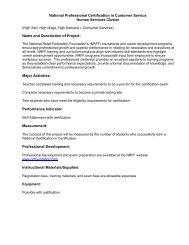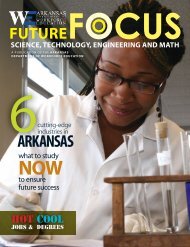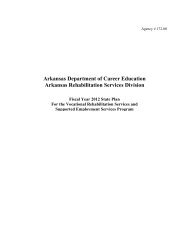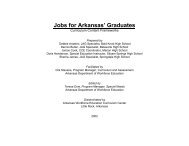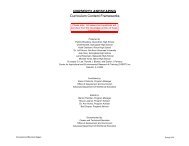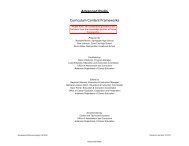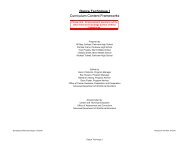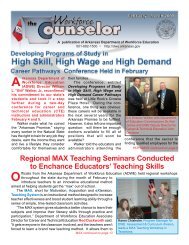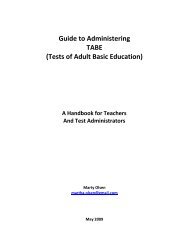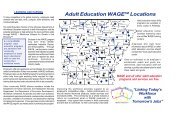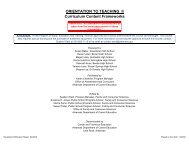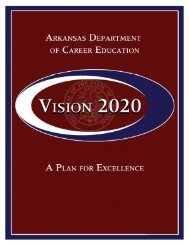Introduction to world agriculture science curriculum content framework
Introduction to world agriculture science curriculum content framework
Introduction to world agriculture science curriculum content framework
You also want an ePaper? Increase the reach of your titles
YUMPU automatically turns print PDFs into web optimized ePapers that Google loves.
INTRODUCTION TO WORLD AGRICULTURE SCIENCE<br />
Curriculum Content Framework<br />
Prepared By<br />
Amie Busby, Greene County Tech High School<br />
Rick Zeigler, Yellville-Summit High School<br />
Facilitated By<br />
Karen Chisholm, Program Manager<br />
Office of Assessment and Curriculum<br />
Arkansas Department of Workforce Education<br />
Edited By<br />
Angela Collins, Program Advisor<br />
Office of Agricultural Science and Technology<br />
Arkansas Department of Workforce Education<br />
Disseminated By<br />
Office of Assessment and Curriculum<br />
Career and Technical Education<br />
Arkansas Department of Workforce Education<br />
Development/Revision Began: 11/2003 Placed on the Web: 9/2004
Curriculum Content Framework<br />
INTRODUCTION TO WORLD AGRICULTURAL SCIENCE<br />
Grade Levels: 7, 8<br />
Prerequisites: None<br />
Course Code: 391025<br />
Course Description: This is a foundation course for <strong>agriculture</strong> courses. Basic <strong>agriculture</strong> concepts are introduced, and students explore careers in<br />
the <strong>agriculture</strong> industry. Students will also be introduced <strong>to</strong> the FFA, leadership, and Supervised Agricultural Experiences.<br />
Table of Contents<br />
Unit 1: Agriculture in Our Lives .................................................................................................................................................................................. 1<br />
Unit 2: The National FFA Organization...................................................................................................................................................................... 3<br />
Unit 3: Animals in Agriculture..................................................................................................................................................................................... 5<br />
Unit 4: Plants in Agriculture ....................................................................................................................................................................................... 6<br />
Unit 5: Natural Resources.......................................................................................................................................................................................... 7<br />
Page<br />
<strong>Introduction</strong> <strong>to</strong> World Agricultural Science
Unit 1: Agriculture in Our Lives<br />
20 Hours<br />
Terminology: Agribusiness, Agricultural mechanics, Agriculture, Agri<strong>science</strong>, Animal <strong>science</strong>, Biology, Export, Forestry, Horticulture, Import,<br />
Technology<br />
CAREER AND TECHNICAL SKILLS<br />
What the Student Should Be Able <strong>to</strong> Do<br />
ACADEMIC AND WORKPLACE SKILLS<br />
What the Instruction Should Reinforce<br />
Knowledge Application Skill Group Skill Description<br />
1.1 Define terms Foundation Reading Applies/Understands technical<br />
words that pertain <strong>to</strong> subject<br />
(1.3.6)<br />
1.2 Identify ways in which<br />
<strong>agriculture</strong> affects us every<br />
day<br />
1.3 Explain the importance of<br />
<strong>agriculture</strong> <strong>to</strong> the economy<br />
of the United States<br />
1.2.1 List 100 agricultural products Foundation<br />
1.3.1 Use a math problem <strong>to</strong> describe<br />
the importance of <strong>agriculture</strong> <strong>to</strong><br />
the economy<br />
Interpersonal<br />
Foundation<br />
Speaking<br />
Teamwork<br />
Arithmetic/<br />
Mathematics<br />
Communicates a thought, idea, or<br />
fact in spoken form [1.5.5]<br />
Contributes <strong>to</strong> group with ideas,<br />
suggestions, and effort [2.6.2]<br />
Applies addition, subtraction,<br />
multiplication, and division <strong>to</strong> real<strong>world</strong><br />
situations [1.1.1]<br />
Reading<br />
Draws conclusions from what is<br />
read [1.3.12]<br />
1.4 Discuss ways <strong>agriculture</strong><br />
has changed during the past<br />
100 years<br />
Thinking<br />
Foundation<br />
Reasoning<br />
Arithmetic/<br />
Mathematics<br />
Uses logic <strong>to</strong> draw conclusions<br />
from available information [4.5.6]<br />
Uses quantitative data <strong>to</strong><br />
construct logical explanations for<br />
real-<strong>world</strong> situations [1.1.39]<br />
Listening<br />
Listens for <strong>content</strong> [1.2.3]<br />
Thinking<br />
Seeing Things in the Imagines the flow of work<br />
Mind’s Eye activities from narrative<br />
<strong>Introduction</strong> <strong>to</strong> World Agriculture Science<br />
Page 1
CAREER AND TECHNICAL SKILLS<br />
What the Student Should Be Able <strong>to</strong> Do<br />
ACADEMIC AND WORKPLACE SKILLS<br />
What the Instruction Should Reinforce<br />
Knowledge Application Skill Group Skill Description<br />
descriptions [4.6.1]<br />
1.5 Identify careers in<br />
agri<strong>science</strong>, production<br />
<strong>agriculture</strong>, agribusiness,<br />
agricultural mechanics,<br />
horticulture, forestry, and<br />
animal <strong>science</strong><br />
1.5.1 Invite speakers from each area<br />
<strong>to</strong> talk <strong>to</strong> the class about their<br />
profession<br />
Foundation<br />
Personal<br />
Management<br />
Listening<br />
Arithmetic/<br />
Mathematics<br />
Career Awareness,<br />
Development, &<br />
Mobility<br />
Listens for <strong>content</strong> [1.2.3]<br />
Uses quantitative data <strong>to</strong><br />
construct logical explanations for<br />
real-<strong>world</strong> situations [1.1.39]<br />
Explores career opportunities<br />
[3.1.6]<br />
Identifies education and training<br />
needed <strong>to</strong> achieve goals [3.1.8]<br />
<strong>Introduction</strong> <strong>to</strong> World Agriculture Science<br />
Page 2
Terminology: American Star Farmer, CDE, SAE, Smith-Hughes Act<br />
Unit 2: The National FFA Organization<br />
20 Hours<br />
CAREER AND TECHNICAL SKILLS<br />
What the Student Should Be Able <strong>to</strong> Do<br />
ACADEMIC AND WORKPLACE SKILLS<br />
What the Instruction Should Reinforce<br />
Knowledge Application Skill Group Skill Description<br />
2.1 Define terms Foundation Reading Applies/Understands technical<br />
words that pertain <strong>to</strong> subject<br />
2.2 List the official FFA colors Foundation Reading Comprehends written information<br />
for main ideas [1.3.7]<br />
2.3 Recite the FFA mot<strong>to</strong> Foundation Speaking<br />
Applies/Uses technical terms as<br />
appropriate <strong>to</strong> audience [1.5.2]<br />
2.4 Illustrate major events in the<br />
his<strong>to</strong>ry of the FFA<br />
2.4.1 Construct a timeline illustrating<br />
major events in the his<strong>to</strong>ry of<br />
FFA using the Official FFA<br />
Manual Chronological His<strong>to</strong>ry<br />
Personal<br />
Management<br />
Foundation<br />
Responsibility<br />
Reading<br />
Writing<br />
Sets high standards for self in<br />
completion of a task [3.4.9]<br />
Comprehends written information<br />
and applies it <strong>to</strong> a task [1.3.8]<br />
Composes and creates a<br />
document—letters, manuals,<br />
reports, proposals, graphs, flow<br />
charts, etc. [1.6.8]<br />
Thinking<br />
Seeing Things in the Imagines the flow of work<br />
Mind’s Eye activities from narrative<br />
descriptions [4.6.1]<br />
<strong>Introduction</strong> <strong>to</strong> World Agriculture Science<br />
Page 3
CAREER AND TECHNICAL SKILLS<br />
What the Student Should Be Able <strong>to</strong> Do<br />
ACADEMIC AND WORKPLACE SKILLS<br />
What the Instruction Should Reinforce<br />
Knowledge Application Skill Group Skill Description<br />
2.5 Explain the purpose of SAEs Foundation<br />
Arithmetic/<br />
Mathematics<br />
Applies addition, subtraction,<br />
multiplication, and division <strong>to</strong> real<strong>world</strong><br />
situations [1.1.1]<br />
Personal<br />
Management<br />
Writing<br />
Responsibility<br />
Organizes information in an<br />
appropriate format [1.6.10]<br />
Maintains a high level of<br />
concentration in completion of a<br />
task [3.4.7]<br />
<strong>Introduction</strong> <strong>to</strong> World Agriculture Science<br />
Page 4
Unit 3: Animals in Agriculture<br />
20 Hours<br />
Terminology: Barrow, Beef, Boar, Bull, Calf, Cow, Ewe, Gilt, Heifer, Hen, Lamb, Lives<strong>to</strong>ck, Mut<strong>to</strong>n, Pork, Poultry, Ram, Sow, Steer, Wether<br />
CAREER AND TECHNICAL SKILLS<br />
What the Student Should Be Able <strong>to</strong> Do<br />
ACADEMIC AND WORKPLACE SKILLS<br />
What the Instruction Should Reinforce<br />
Knowledge Application Skill Group Skill Description<br />
3.1 Define terms Foundation Reading Applies/Understands technical<br />
words that pertain <strong>to</strong> subject<br />
[1.3.6]<br />
3.2 List products obtained from<br />
animals<br />
Foundation<br />
Reading<br />
Adjusts reading strategy <strong>to</strong><br />
purpose and type of reading<br />
(skimming and scanning) [1.3.1]<br />
3.3 Match cuts of meat <strong>to</strong> the<br />
animals from which they are<br />
derived<br />
Personal<br />
Management<br />
Foundation<br />
Responsibility<br />
Reading<br />
Exerts a high level of effort and<br />
perseverance <strong>to</strong>ward goal<br />
attainment [3.4.4]<br />
Uses written resources (books,<br />
dictionaries, direc<strong>to</strong>ries) <strong>to</strong> obtain<br />
factual information [1.3.23]<br />
Thinking<br />
Reasoning<br />
Extracts rules or principles from<br />
written information [4.5.4]<br />
<strong>Introduction</strong> <strong>to</strong> World Agriculture Science<br />
Page 5
Unit 4: Plants in Agriculture<br />
20 Hours<br />
Terminology: Flower, Leaf, Pho<strong>to</strong>synthesis, Respiration, Root, Stem, Transpiration<br />
CAREER AND TECHNICAL SKILLS<br />
What the Student Should Be Able <strong>to</strong> Do<br />
ACADEMIC AND WORKPLACE SKILLS<br />
What the Instruction Should Reinforce<br />
Knowledge Application Skill Group Skill Description<br />
4.1 Define terms Foundation Reading Applies/Understands technical<br />
words that pertain <strong>to</strong> subject<br />
[1.3.6]<br />
4.2 Discuss ways plants affect<br />
our lives<br />
4.2.1 Take students on a <strong>to</strong>ur of the Foundation<br />
campus <strong>to</strong> identify different types<br />
of plants<br />
Speaking<br />
Participates in conversation,<br />
discussion, and group<br />
presentations [1.5.8]<br />
4.3 Label the four major parts of<br />
a plant, and discuss their<br />
functions<br />
4.4 Identify requirements for<br />
plant growth<br />
Thinking<br />
Foundation<br />
Personal<br />
Management<br />
Foundation<br />
Reasoning<br />
Reading<br />
Responsibility<br />
Speaking<br />
Sees relationship between two or<br />
more ideas, objects, or situations<br />
[4.5.5]<br />
Identifies relevant details, facts,<br />
and specifications [1.3.16]<br />
Exhibits enthusiasm in<br />
approaching and completing a<br />
task [3.4.3]<br />
Asks questions <strong>to</strong> obtain<br />
information [1.5.4]<br />
Thinking<br />
Seeing Things in the Organizes and processes images<br />
Mind’s Eye –symbols, pictures, graphs,<br />
objects, etc. [4.6.2]<br />
<strong>Introduction</strong> <strong>to</strong> World Agriculture Science<br />
Page 6
Unit 5: Natural Resources<br />
10 Hours<br />
Terminology: Clay, Conservation, Habitat, Preda<strong>to</strong>rs, Prey, Sand, Silt, Soil, Texture<br />
CAREER AND TECHNICAL SKILLS<br />
What the Student Should Be Able <strong>to</strong> Do<br />
ACADEMIC AND WORKPLACE SKILLS<br />
What the Instruction Should Reinforce<br />
Knowledge Application Skill Group Skill Description<br />
5.1 Define terms Foundation Reading Applies/Understands technical<br />
words that pertain <strong>to</strong> subject<br />
[1.3.6]<br />
5.2 Explain why conservation of<br />
natural resources is<br />
important<br />
5.2.1 Discuss strategies for conservingFoundation<br />
natural resources<br />
Science<br />
Analyzes environmental issues<br />
(ecology, pollution, waste<br />
management) [1.4.2]<br />
5.3 Identify the major<br />
components of soil<br />
5.3.1 Determine the texture of soil<br />
samples<br />
Personal<br />
Management<br />
Foundation<br />
Integrity/Honesty/<br />
Work Ethic<br />
Arithmetic/<br />
Mathematics<br />
Describes/Explains significance of<br />
integrity, honesty, and work ethics<br />
[3.2.4]<br />
Calculates percentages, rations,<br />
proportions, decimals, and<br />
common fractions [1.1.10]<br />
Science<br />
Acquires and processes scientific<br />
data [1.4.1]<br />
5.4 Identify major species of<br />
wildlife in Arkansas<br />
5.4.1 Use the Arkansas Game and<br />
Fish Regulations Guide as a<br />
reference<br />
Thinking<br />
Foundation<br />
Thinking<br />
Knowing how <strong>to</strong><br />
Learn<br />
Reading<br />
Reasoning<br />
Processes new information as<br />
related <strong>to</strong> workplace [4.3.5]<br />
Determines what information is<br />
needed [1.3.10]<br />
Uses logic <strong>to</strong> draw conclusions<br />
from available information [4.5.6]<br />
<strong>Introduction</strong> <strong>to</strong> World Agriculture Science<br />
Page 7
Glossary<br />
Unit 1: Agriculture in Our Lives<br />
1. Agribusiness—businesses involved in the field of <strong>agriculture</strong><br />
2. Agricultural mechanics—relating <strong>to</strong> the design, operation, and maintenance of mechanical equipment in <strong>agriculture</strong><br />
3. Agriculture—the <strong>science</strong> of production of food, fiber, and related supplies, services, mechanics, products, processing, and marketing<br />
4. Agri<strong>science</strong>—application of scientific principles and new technologies <strong>to</strong> <strong>agriculture</strong><br />
5. Animal <strong>science</strong>—the <strong>science</strong> of animal growth, care, and management<br />
6. Biology—the field of study dealing with living organisms<br />
7. Export—products sold and transported <strong>to</strong> other countries<br />
8. Forestry—the <strong>science</strong> of growing trees<br />
9. Horticulture—the <strong>science</strong> of growing fruits, flowers, vegetables, or ornamental plants<br />
10. Import—products brought in<strong>to</strong> a country from another country<br />
11. Technology—advancements in <strong>science</strong> <strong>to</strong> improve the standard of living<br />
<strong>Introduction</strong> <strong>to</strong> World Agriculture Science<br />
Page 8
Unit 2:<br />
The National FFA Organization<br />
1. American Star Farmer—highest FFA award achieved at the national level<br />
2. CDE—Career Development Event that allows for knowledge and skill development through competition in agribusiness and agri<strong>science</strong><br />
3. SAE—supervised <strong>agriculture</strong> experience program; projects supervised by a teacher that help students gain knowledge and skills in<br />
<strong>agriculture</strong><br />
4. Smith-Hughes Act—a federal law passed in 1917 creating vocational education in public schools<br />
<strong>Introduction</strong> <strong>to</strong> World Agriculture Science<br />
Page 9
Unit 3: Animals in Agriculture<br />
1. Barrow—a male swine castrated at an early age<br />
2. Beef—the meat obtained from cattle<br />
3. Boar—a male swine that has not been castrated<br />
4. Bull—a male bovine that has not been castrated<br />
5. Calf—a member of the bovine species under one year of age<br />
6. Cow—a female bovine that has produced one or more calves<br />
7. Ewe—a female sheep<br />
8. Gilt—a female swine that has not produced a litter of piglets<br />
9. Heifer—a female bovine that has not produced a calf<br />
10. Hen—a female fowl<br />
11. Lamb—any sheep under 12 months of age<br />
12. Lives<strong>to</strong>ck—animals used for production <strong>agriculture</strong><br />
13. Mut<strong>to</strong>n—sheep over one year of age, castrated while a lamb; also meat of sheep<br />
14. Pork—meat from pigs<br />
15. Poultry—domestic fowl that are raised for meat, eggs, and/or feathers<br />
16. Ram—a male sheep that has not been castrated<br />
17. Sow—a female swine that has produced a litter of piglets<br />
18. Steer—a male bovine that has been castrated at an early age<br />
19. Wether—a castrated male sheep<br />
<strong>Introduction</strong> <strong>to</strong> World Agriculture Science<br />
Page 10
Unit 4:<br />
Plants in Agriculture<br />
1. Flower—the reproductive part of the plant<br />
2. Leaf—the part of a plant that manufactures food through pho<strong>to</strong>synthesis<br />
3. Pho<strong>to</strong>synthesis—the process of changing light energy in<strong>to</strong> chemical energy; input of carbon dioxide and water in the presence of sunlight <strong>to</strong><br />
produce glucose, water, and oxygen<br />
4. Respiration—a process that breaks down sugars <strong>to</strong> produce energy<br />
5. Root—a vegetative part of a plant that grows underground and is used as an anchor and for absorption of water, nutrients, and gases<br />
6. Stem—a vegetative part of a plant that supports leaves, buds, and other organs<br />
7. Transpiration—the loss of water vapor from a plant<br />
<strong>Introduction</strong> <strong>to</strong> World Agriculture Science<br />
Page 11
Unit 5:<br />
Natural Resources<br />
1. Clay—a microscopic soil particle that has the highest moisture retention<br />
2. Conservation—the wise use of natural resources<br />
3. Habitat—components that make up an animal’s living environment<br />
4. Preda<strong>to</strong>rs—animals that feed on smaller or weaker animals<br />
5. Prey—an animal eaten by another animal<br />
6. Sand—the largest soil particle with the highest drainage potential and lowest nutrient retention<br />
7. Silt—an intermediate soil particle with medium drainage and nutrient retention<br />
8. Soil—the mineral and organic surface of the Earth; capable of supporting upland plants<br />
9. Texture—the ratio of sand, silt, and clay in a given soil<br />
<strong>Introduction</strong> <strong>to</strong> World Agriculture Science<br />
Page 12



